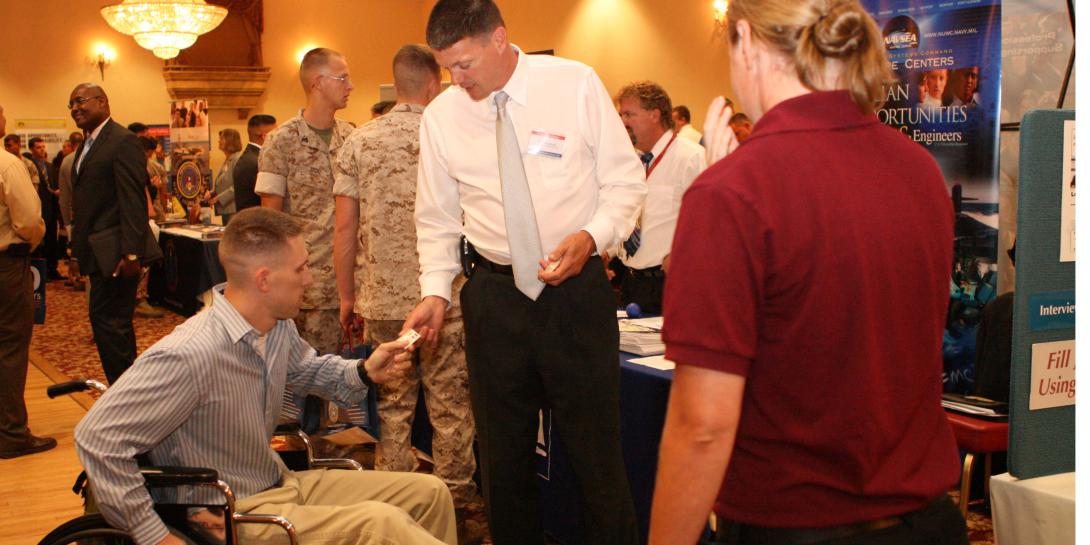This Veterans Day, Some Companies Say 'Thank You' With the Words: 'You're Hired'
More than two decades of continuous combat have taken a toll on U.S. forces and highlighted many issues that plague the military, from homeless veterans to suicides and medical treatment backlogs. Many companies have public and private campaigns working to reverse the difficulties, matching veterans looking for work with companies looking to hire.
Hiring veterans is more than a patriotic gesture—it makes good business sense, offers Susan Fallon, vice president of global strategies and business development at Monster Government Solutions. Business leaders recognize veterans not only for their talents and work experiences, but also for their leadership skills and their adherence to discipline, teamwork, time management and respect for the hierarchy.
“It’s good for employers and good for veterans, who are a tremendously talented and a proven work force—the kind of folks you want in your companies,” Fallon says.
More than two decades of continuous combat have taken a toll on U.S. forces and highlighted many issues that plague the military. In response, federal and private campaigns address the problems, which include housing homeless veterans, suicide prevention quests, better medical care opportunities and now a new campaign asking that during November, supporters “Greenlight A Vet” by shining a green light in their homes or offices every day as a gesture of veteran appreciation and support.
As the nation commemorates Veterans Day, the timing is right to draw attention to endeavors to match veterans looking for work with companies looking to hire.
For several years, federal agencies and the private industry sunk a lot of effort and money into curbing the problem of veteran unemployment just as the nation as a whole battled to recover from a recession.
The government reported the unemployment rate for veterans hit a seven-year low last month. Veterans faced a 3.9 percent unemployment rate in October, down from a 4.5 percent rate for the same month last year, according to data from the Bureau of Labor Statistics. The unemployment rate last month was 3.7 percent for veteran men and 5.4 percent for veteran women. The nation’s overall unemployment rate hovered at 5 percent.
The Department of Veterans Affairs initiated VA for Vets, a program that facilitates the reintegration, retention and hiring of veterans within the department.
Additionally, after the successful push of the online job-finding tool called OhioMeansJobs, Monster launched OhioMeansVeteransJobs, linking veterans with vacancies and showcasing a tool that helps them translate their military work jargon to a civilian-friendly resume.
“There’s a whole section on the site devoted to helping military service members transition out and integrate into the Ohio community,” Fallon explains. The effort has flourished and the organization seeks to expand to other states.
For several years, an area of focus for both Monster.com and Military.com has been around veteran employment. The websites offer members the skills translator, which lets service members insert their military occupational specialty codes, ranks, years of service and any collateral duties, subspecialties and training courses. The program then churns out a resume that eliminates the military jargon that means little to civilian companies. “And, the algorithm that runs behind the scenes as the service member puts the information in immediately matches them to open positions,” she adds.
Twice a year, Monster Government runs a veterans talent index that matches the number of veterans looking for jobs with company seeking to fill vacancies. “When you have Military.com and Monster, and there are 970,000-plus veteran resumes, we have a unique perspective into the supply side,” Fallon says.
Other ventures include a partnership with the Northern Virginia Technology Council and the Consumer Electronics Association to create a regional industry focus on veteran recruitment issues and solutions, she shares. “Consistently, the number one challenge we hear from both sides is communication problems; the challenge of articulating and finding a good fit between service members and the skills and experience they’ve developed during their time in the military.”
Matching veterans with jobs is not the sole focus of the company’s efforts to help the federal government update an antiquated hiring process, especially in area of much-needed technology talent across cyber and data sciences. “The other side of what we do is helping agencies find and develop that best talent,” Fallon says. “That’s where we get to take all of the technology, the know-how, the brand and the reach of Monster and configure that specifically for the public sector.”
The technologies help the Defense Department, for example, replace its retiring work force, where the average employee is older than 52. The agency wants to lure the digitally savvy millennial generation to government jobs: “An environment where they can not only find a job, but where they can navigate their way to a career,” Fallon says.
“We’re seeing state and local employers take a more creative and proactive approach in helping this generation—used to tapping the power of the Internet with a couple of clicks—make an educated decision when they comparison shop for jobs," she adds. “We definitely see, particularly in the federal recruiting area, the government getting more creative along those lines to help attract and compete for that talent, and then to keep them.”





Comments